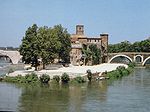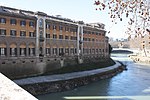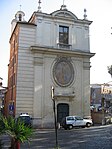Pons Cestius
Bridges completed in the 1st century BCBridges in RomeDeck arch bridgesRoman bridges in ItalyRome R. XIII Trastevere ... and 2 more
Rome R. XII RipaStone bridges in Italy

The Pons Cestius (Italian: Ponte Cestio) is an ancient Roman bridge connecting the right bank of the Tiber with the west of the Tiber Island in Rome, Italy. In Late Antiquity, the bridge was replaced and renamed the Pons Gratiani. It is also known as the Italian: Ponte San Bartolomeo, lit. 'Bridge of Saint Bartholomew'. No more than one third of the present stone bridge is of ancient material, as it was entirely rebuilt and extended in the 19th century, after numerous earlier restorations.
Excerpt from the Wikipedia article Pons Cestius (License: CC BY-SA 3.0, Authors, Images).Pons Cestius
Pista ciclabile del Tevere, Rome Municipio Roma I
Geographical coordinates (GPS) Address External links Nearby Places Show on map
Geographical coordinates (GPS)
| Latitude | Longitude |
|---|---|
| N 41.890222222222 ° | E 12.477222222222 ° |
Address
Ponte Cestio (Ponte di San Bartolomeo)
Pista ciclabile del Tevere
00153 Rome, Municipio Roma I
Lazio, Italy
Open on Google Maps










